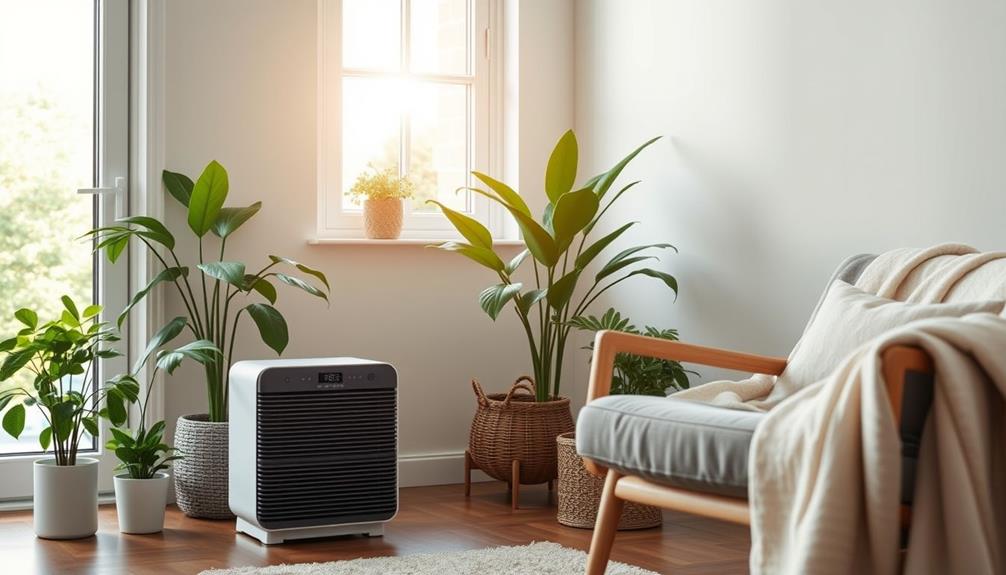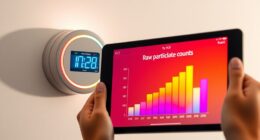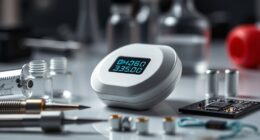If you're managing asthma, having the right air purifier can make a big difference. Look for models with HEPA filters, which capture 99.97% of airborne allergens like pollen and dust mites. A Clean Air Delivery Rate (CADR) of at least 225 CFM is perfect for effective air cleaning. Position your purifier in key areas and keep it running continuously for maximum benefit. Remember to maintain the filters regularly for peak performance. With the right purifier and setup, you can greatly reduce asthma triggers at home. Explore further to uncover tips on choosing and enhancing your air purifier for better health.
Key Takeaways
- Air purifiers with true HEPA filters capture 99.97% of particles, reducing asthma symptoms effectively.
- Choose air purifiers with a CADR of at least 225 CFM for optimal air cleaning performance.
- Place air purifiers in key areas and maintain regular filter replacement for peak efficiency.
- Address common asthma triggers like dust mites, pollen, and mold alongside using air purifiers.
- Consider budget-friendly options and smart features to enhance asthma management through cleaner air.
Understanding Asthma and Air Purifiers
Asthma affects millions of people worldwide, making it essential to understand how air purifiers can help manage this condition. Air purifiers help you tackle indoor air quality issues by effectively removing airborne irritants that may trigger asthma symptoms. They work by filtering out allergens and pollutants, such as dust, pollen, and pet dander, which are common asthma triggers. Incorporating devices like ozone air purifiers can further enhance air quality by neutralizing persistent odors and allergens.
Most air purifiers utilize HEPA filters, known for their ability to capture 99.97% of particles as small as 0.3 microns. This means they can considerably clean the air in your home, reducing exposure to harmful air pollution.
By maintaining a cleaner indoor environment, air purifiers can lessen the frequency of asthma flare-ups and decrease your reliance on medications.
Regular use of air purifiers creates an effective air quality improvement strategy. You'll notice a difference in how you feel, as the removal of airborne irritants leads to a healthier living space.
Investing in an air purifier can be a considerable step toward managing your asthma and enhancing your overall well-being.
Choosing the Right Air Purifier
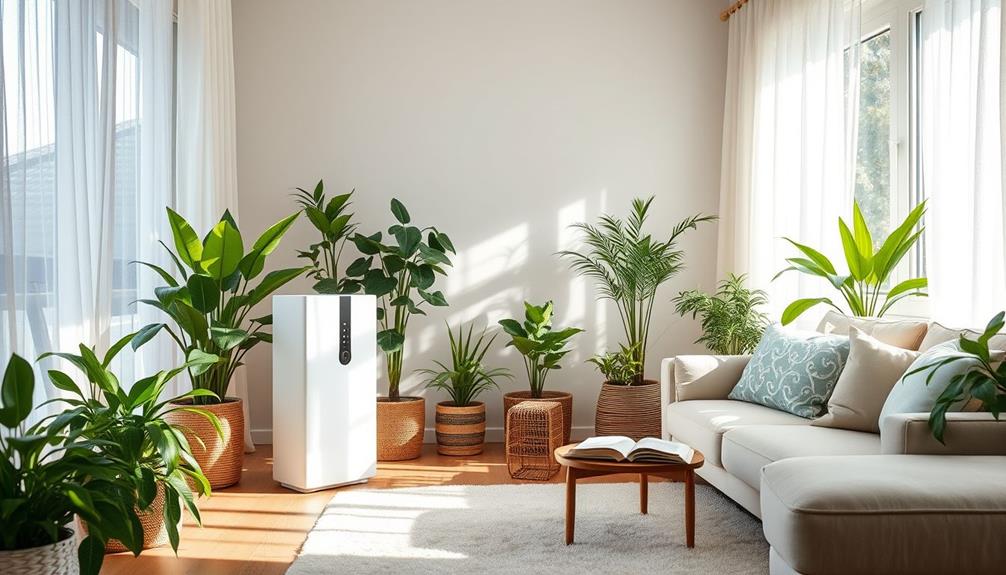
When managing asthma, selecting the right air purifier can greatly influence your indoor air quality and overall well-being. Start by looking for models equipped with True HEPA filters, which capture 99.97% of particles as small as 0.3 microns. This feature is essential for removing asthma-triggering allergens like pollen and dust mites from your space.
Additionally, adopting a healthy lifestyle can complement your efforts in minimizing asthma symptoms by ensuring a balanced diet and regular physical activity.
Next, consider the Clean Air Delivery Rate (CADR); a minimum score of 225 CFM is ideal for effective air cleaning in your home. It's also important to match the air purifier size to your room dimensions. A unit designed for 400 sq. ft. won't effectively purify larger areas.
Don't overlook the noise level, especially if you're using it in a bedroom. Quieter models below 55 dB are preferable to avoid disrupting your sleep.
Setting Up Your Air Purifier
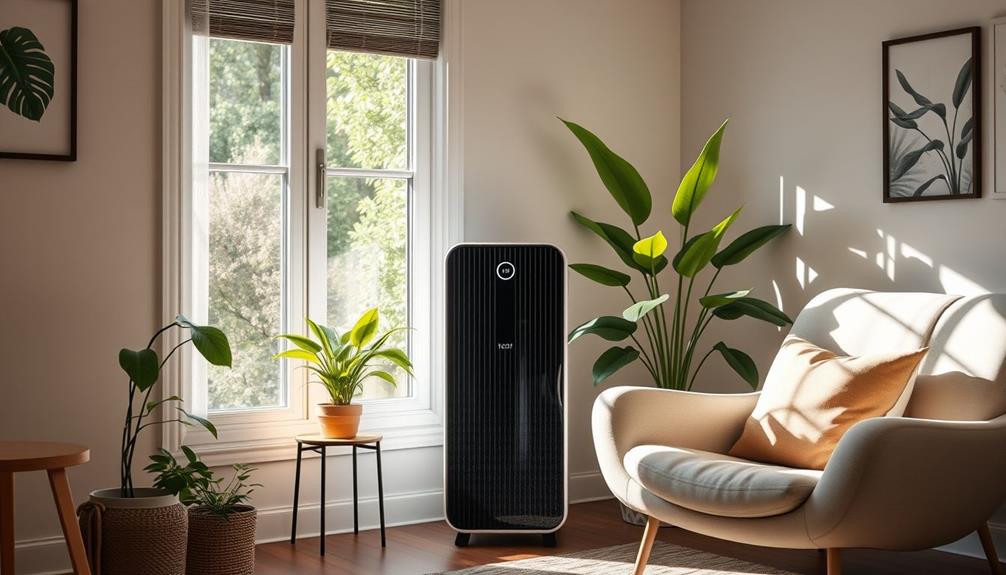
To maximize the effectiveness of your air purifier, strategically place it in key areas like bedrooms and living rooms where you spend the most time. These ideal locations enhance air quality and create a more comfortable environment.
Additionally, consider incorporating visible security measures to deter potential intruders, as home security systems also contribute to a safer indoor atmosphere. Make certain your air purifier isn't obstructed by furniture or walls; this allows for maximum airflow and efficiency.
If you're dealing with larger spaces, consider using multiple air purifiers to cover more area and improve overall air quality. This approach guarantees that every corner of your home benefits from cleaner air.
For the best results, operate your air purifier continuously and keep doors and windows closed to maintain a controlled environment free of outdoor pollutants.
Regular filter maintenance is vital for peak performance. Follow the manufacturer's guidelines for filter replacement, typically every 6-12 months. Keeping up with this maintenance guarantees that your air purifier operates at its best, effectively reducing allergens and irritants in your home.
Best Air Purifiers for Different Needs

Finding the right air purifier can make a significant difference in your indoor air quality, especially if you have specific needs or preferences. For effective asthma management, the Levoit EverestAir stands out as the best air purifier, boasting a clean air delivery rate (CADR) of 360 CFM, cleaning a 563 sq. ft. room in just 13 minutes.
Proper air quality is essential, particularly for individuals with asthma, as it can reduce triggers and improve breathing asthma exacerbations can result in phlegm production. If you need a quieter option, the Smart Air Blast Mini operates at a maximum noise level of 49 dB while covering 703 sq. ft. with a CADR of 435 CFM.
For larger spaces, consider the Levoit Core 600S, which combines smart features with a CADR of 410 CFM, effectively cleaning spaces in 15 minutes. If you're on a budget, the Levoit Core 400S is a budget-friendly option for small rooms up to 403 sq. ft. and offers a filter life of approximately 12 months.
Finally, if VOCs are a concern, the IQAir HealthPro Plus excels in eliminating these harmful particles in the air, cleaning up to 1125 sq. ft. in just 25 minutes.
Choose the right air purifier for asthma to guarantee cleaner air and better health.
Importance of HEPA Filters
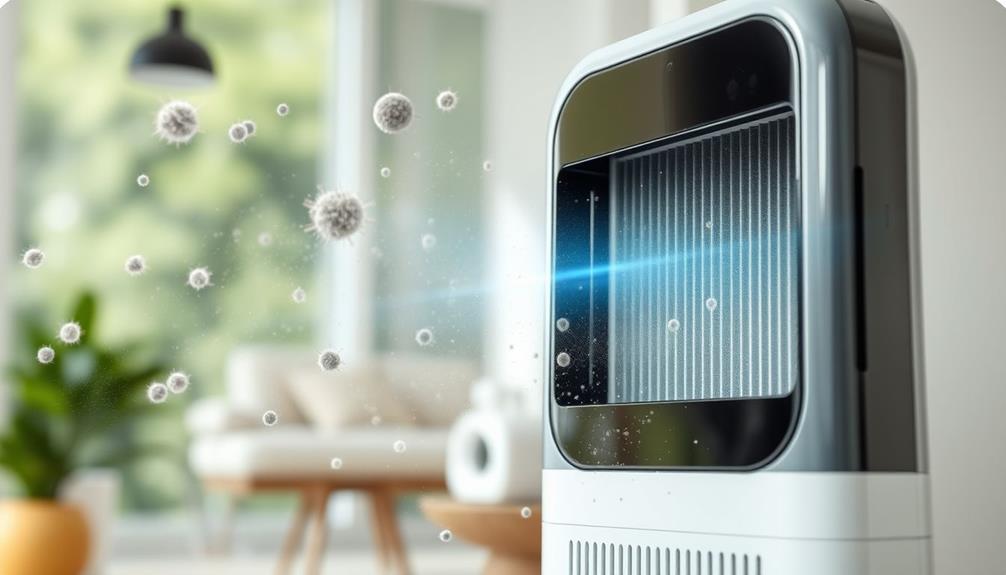
Choosing the right air purifier goes beyond just selecting a model; it's also about understanding the significance of the filters it uses. HEPA filters are crucial for anyone managing asthma. These filters capture 99.97% of airborne particles as small as 0.3 microns, effectively removing asthma-triggering allergens like pollen, dust mites, and pet dander.
Additionally, it's important to take into account how air quality impacts overall health and well-being, especially for those with respiratory conditions. Researching reputable brands can help you find reputable air purifier providers that prioritize effective filtration.
The efficiency of HEPA filters directly impacts your indoor air quality, as they greatly reduce levels of particulate matter (PM2.5) known to worsen respiratory symptoms. When choosing an air purifier, look for a model with a Clean Air Delivery Rate (CADR) score of at least 225 CFM. This guarantees rapid air purification, which is essential for keeping your environment safe from harmful particles.
Using True HEPA filtration not only helps in improving air quality but also contributes to fewer asthma flare-ups, enhancing your overall quality of life. Brands like Smart Air offer HEPA-only models that focus on performance and cost-effectiveness, making certain you get the best air cleaning solution tailored to your asthma-related needs.
Prioritizing HEPA filters is a smart step toward better health and comfort.
Common Asthma Triggers and Solutions
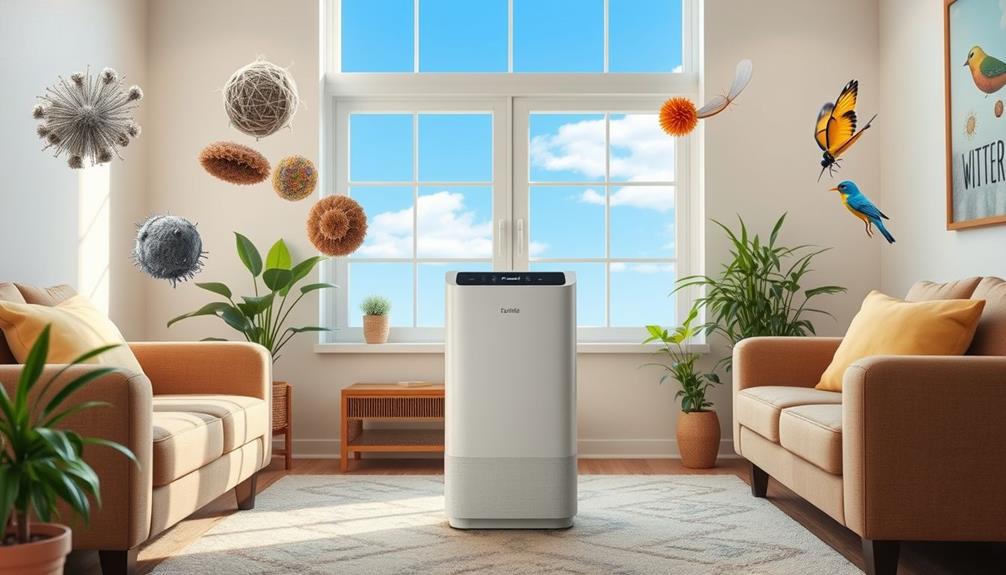
Asthma can be triggered by various common allergens and irritants found in our homes and environments. Dust mites are one of the main asthma triggers, thriving in bedding and carpets. To combat this, use allergen-proof covers and clean regularly.
Pollen from trees, grasses, and weeds can also worsen symptoms, so keep your windows closed during high pollen seasons and consider air purifiers with HEPA filters to improve indoor air quality. Understanding these triggers is essential for effective asthma management, similar to how preservation of traditions is important for cultural identity among communities.
Mold growth in damp areas is another notable trigger. You can prevent it by maintaining humidity levels below 50% and using dehumidifiers.
Pet dander is a common irritant as well; regular grooming of pets and utilizing HEPA air purifiers can help reduce dander in your home, benefiting your respiratory health.
Lastly, tobacco smoke is a major irritant for many asthma sufferers. Implementing indoor smoking bans can greatly enhance your indoor air quality and reduce asthma symptoms.
Reducing Asthma Triggers Beyond Air Purifiers

While air purifiers play a notable role in improving indoor air quality, there are several additional strategies to further reduce asthma triggers in your home.
Start by regularly vacuuming with HEPA filter vacuums and dusting with damp cloths. This helps effectively remove allergens like dust mites and pet dander, minimizing potential asthma triggers. Maintaining indoor humidity levels below 50% is vital, as higher humidity can promote mold and dust mites—common irritants for asthma sufferers. Consider using a dehumidifier to achieve this.
Additionally, invest in allergen-proof bedding covers to reduce exposure to dust mites. Implementing a strict no-smoking policy indoors is essential, as secondhand smoke can greatly irritate your respiratory system.
Combining these cleaning and humidity control measures with your air purifiers will create a thorough approach to managing asthma triggers.
| Strategy | Purpose | Benefits |
|---|---|---|
| Vacuum with HEPA filters | Remove allergens like dust mites | Reduces asthma triggers |
| Use dehumidifiers | Maintain humidity below 50% | Prevents mold growth |
| Allergen-proof bedding | Minimize exposure to dust mites | Eases asthma symptoms |
HouseFresh Resources and Credibility
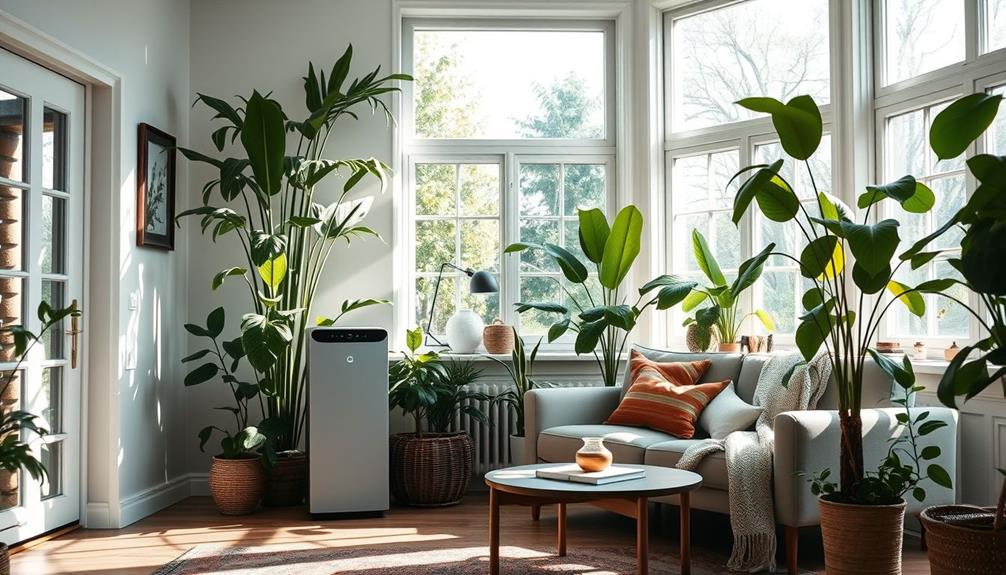
When it comes to finding reliable information about air purifiers, HouseFresh stands out as a credible resource. Since 2010, they've been reviewing air quality products, ensuring their evaluations are unbiased through real-world performance testing. They purchase products themselves, making their assessments trustworthy and relevant to your health needs.
Additionally, understanding the benefits of essential oils can complement your approach to improving air quality and promoting relaxation in your home environment, which is vital for individuals with asthma essential oils for relaxation.
HouseFresh emphasizes transparency by welcoming inquiries about their testing processes, so you can feel confident in their methodologies. Their website is filled with valuable resources, including articles that help you understand how different air purifiers and filters can reduce harmful particles in your environment, especially if you have asthma.
You'll also find tailored recommendations for budget-friendly options, ensuring you can find a solution that fits your needs without breaking the bank. Their commitment to consumer education shines through in detailed analyses and comparisons of air purifiers, specifically designed for individuals with respiratory conditions.
With HouseFresh, you can access the information you need to make informed choices about air purifiers that promote clean air and improve your overall health. Trust their expertise to guide you in selecting the right products for your asthma management.
Conclusion
To sum up, investing in the right air purifier can greatly improve your quality of life if you have asthma. Did you know that using a HEPA filter can reduce airborne allergens by up to 99.97%? That's a game changer for managing your symptoms. By choosing the right model and setting it up properly, you can create a healthier environment at home. Don't forget to tackle other asthma triggers too—it's all about making your space safe and comfortable.
